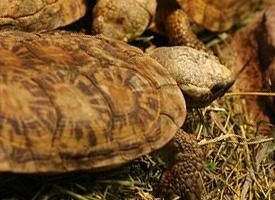
Greutăți și măsuri
| Lungime | de la 16 la 20 cm |
|---|
Descrierea animalului
The Russian tortoise, scientifically known as Testudo horsfieldii, is a small yet captivating species of tortoise that has captured the interest of reptile enthusiasts and conservationists alike. This species, also commonly referred to as the Horsfield's tortoise or Central Asian tortoise, has a rich history and a unique set of characteristics that distinguish it from other members of the Testudinidae family.Physical Description:
Adult Russian tortoises typically reach a shell length of about 15 to 25 centimeters (6 to 10 inches), making them one of the smaller tortoise species. Their carapace, or upper shell, is highly domed and can vary in color from shades of yellow to dark brown, often adorned with distinctive dark markings. These patterns are not only beautiful but also serve as camouflage in their natural habitat. The plastron, or under shell, is lighter in color, ranging from pale yellow to cream. Males can be distinguished from females by their longer tails and the concave shape of their plastrons, adaptations that facilitate mating.
Habitat and Distribution:
The Russian tortoise is native to Central Asia, inhabiting a wide range of environments from dry deserts to lush, grassy meadows. Their distribution spans several countries, including Russia, Iran, Afghanistan, Pakistan, and China. These tortoises have shown remarkable adaptability, thriving in areas with extreme temperature fluctuations. They are particularly adept at surviving in arid conditions, thanks in part to their ability to burrow. These burrows not only provide shelter from predators and extreme weather but also serve as a means of thermoregulation, helping the tortoises maintain their body temperature.
Diet and Nutrition:
Russian tortoises are herbivores, feeding primarily on a variety of leafy greens, flowers, and plants. In the wild, their diet consists of whatever vegetation is available in their arid habitats, including grasses, weeds, and succulents. This diet is low in protein and fat but high in fiber, which is ideal for their digestive system. In captivity, it's crucial to replicate this diet as closely as possible to prevent health issues.
Behavior and Lifestyle:
Known for their hardy nature and resilience, Russian tortoises are solitary animals with a strong instinct for burrowing. They are most active during the cooler parts of the day, such as early morning and late afternoon, to avoid the extreme heat. During the hottest parts of the year, they may estivate, retreating into their burrows for extended periods. Conversely, in colder climates, they enter a state of brumation (a form of hibernation) during the winter months. Mating occurs primarily in the spring, after which females lay a small clutch of eggs in a nest dug into the soil.
Conservation Status:
The Russian tortoise is listed as Vulnerable by the International Union for Conservation of Nature (IUCN), primarily due to habitat loss and the pet trade. Their adaptability has made them popular in the pet industry, but it has also led to overcollection from the wild, which, coupled with habitat destruction, threatens their populations. Conservation efforts are focused on habitat protection, regulating the pet trade, and educating the public about responsible pet ownership.
In Captivity:
Russian tortoises can make rewarding pets for those willing to commit to their specific care requirements. They require a spacious enclosure with appropriate substrate for burrowing, a diet rich in fiber, and access to ultraviolet light to process calcium properly. With proper care, these tortoises can live for over 40 years, making them a long-term commitment.
In summary, the Russian tortoise is a fascinating and resilient species with a unique set of characteristics and behaviors. Their ability to adapt to harsh environments, combined with their distinctive appearance and behaviors, makes them a subject of interest for both scientists and reptile enthusiasts. However, their vulnerability to habitat destruction and the pet trade underscores the importance of conservation efforts to ensure their survival for generations to come.
Animale similare
Fotografii noi cu animale
Top 10 animale
- Dolphin gull (Leucophaeus scoresbii)
- Diana monkey (Cercopithecus diana)
- Moustached guenon (Cercopithecus cephus)
- Galápagos tortoise (Geochelone nigra complex)
- Stone loach (Barbatula barbatula)
- Japanese macaque (Macaca fuscata)
- Russian tortoise (Testudo horsfieldii)
- Greek tortoise (Testudo graeca)
- Common flying dragon (Draco volans)
- Vendace (Coregonus albula)


